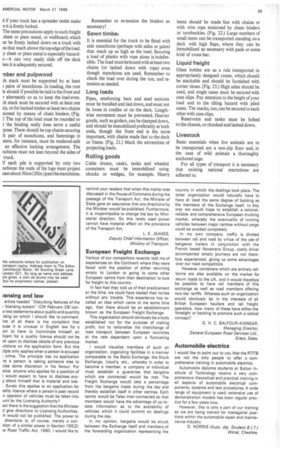Remember to re-tension the binders as necessary!
Page 61

If you've noticed an error in this article please click here to report it so we can fix it.
Sawn timbei It is essential for the truck to be fitted with side stanchions (perhaps with sides or gates) that reach up as high as the load. Securing a load of planks with rope alone is indefensible. The load must be bound with at least two chains (or lashed down with rope) even though stanchions are used. Remember to check the load over during the run, and retension as needed.
Long loads Pipes, reinforcing bars and steel sections must be bundled and tied down, and must not lie loose in cradles or on the deck. Lengthwise movement must be prevented. Heavier goods, such as girders, can be clamped down, and should be immobilized preferably at both ends, though the front end is the more important, with chains made fast to the deck or frame. (Fig. 21.) Mark the extremities of projecting loads.
Rolling goods Cable drums, casks, tanks and wheeled containers must be immobilized using chocks or wedges, for example. Heavy items should be made fast with chains or with wire rope tensioned by chain binders or turnbuckles. (Fig. 22.) Large numbers of small items can be transported standing on a deck with high flaps, where they can be immobilized as necessary with pads or some kind of cross-bar.
Liquid freight Glass bottles are as a rule transported in appropriately designed crates, which should be stackable and should be furnished with corner shoes. (Fig. 23.) High sides should be used, and single cases must be secured with case clips. Pay attention to the height of your load and to the tilting hazard with piled cases. The stacks, too, can be secured to each other with case clips.
Reservoirs and tanks must be bolted to the chassis, or chocked and lashed down.
Livestock Basic essentials when live animals are to be transported are a non-slip floor and, in the case of wild animals a thoroughly anchored cage.
For all types of transport it is necessary that existing national restrictions are adhered to.
























































































































